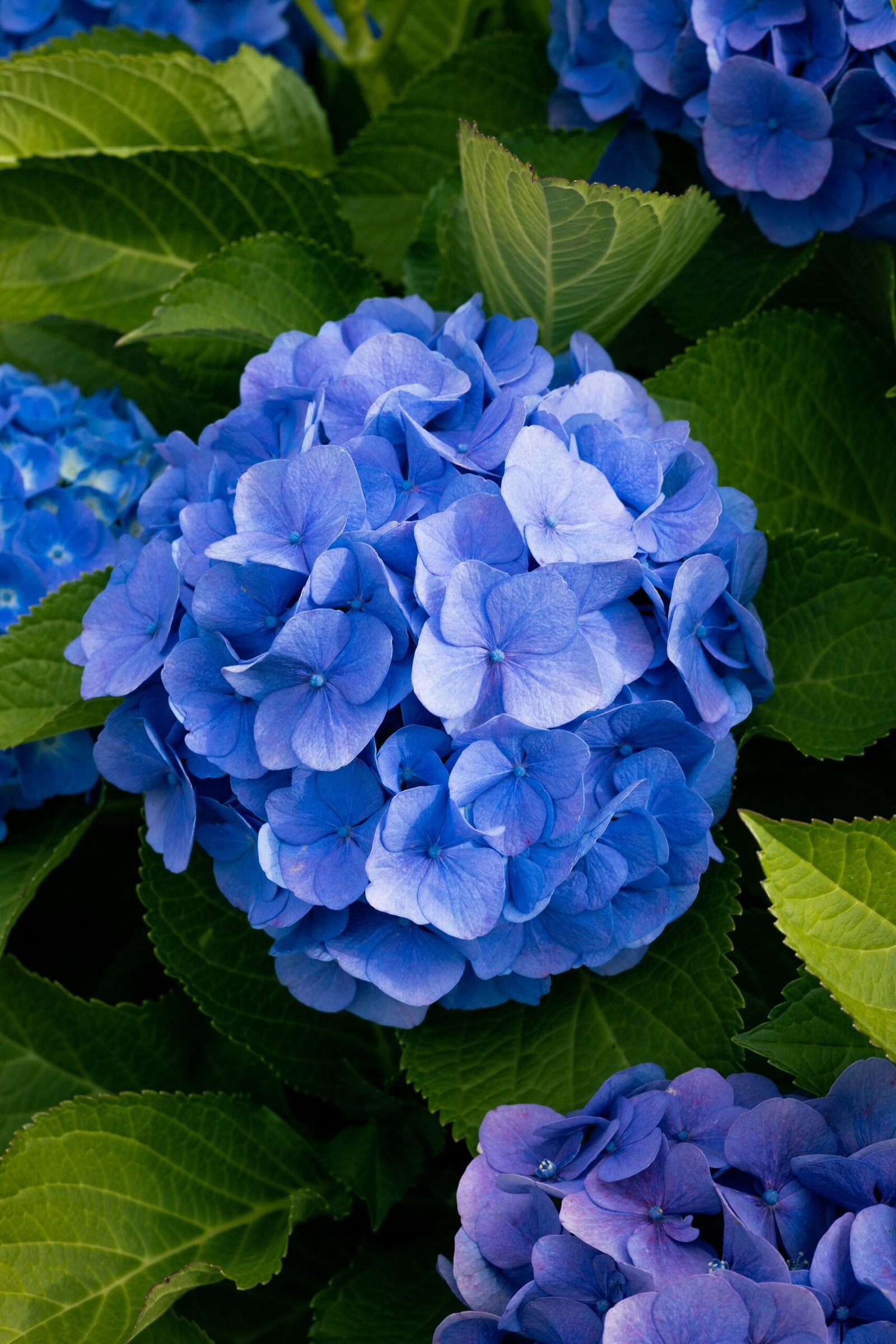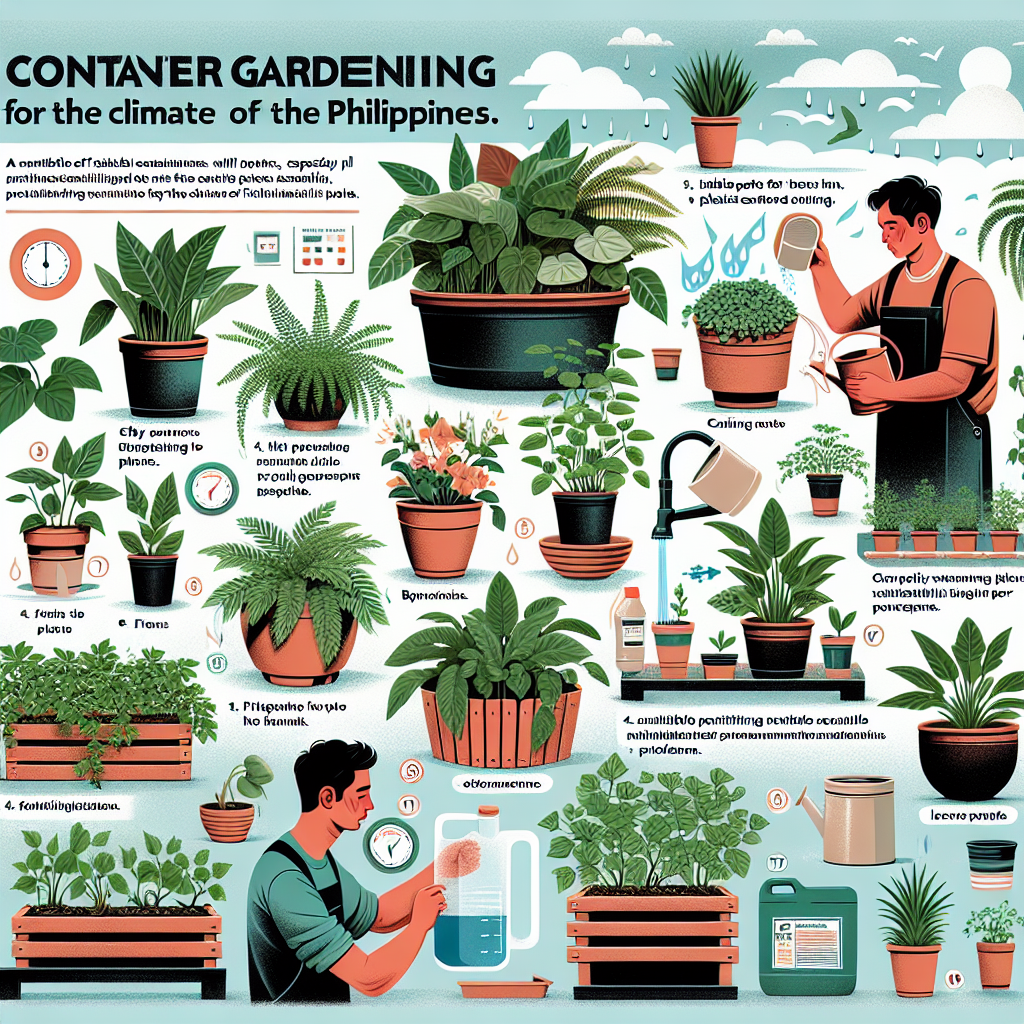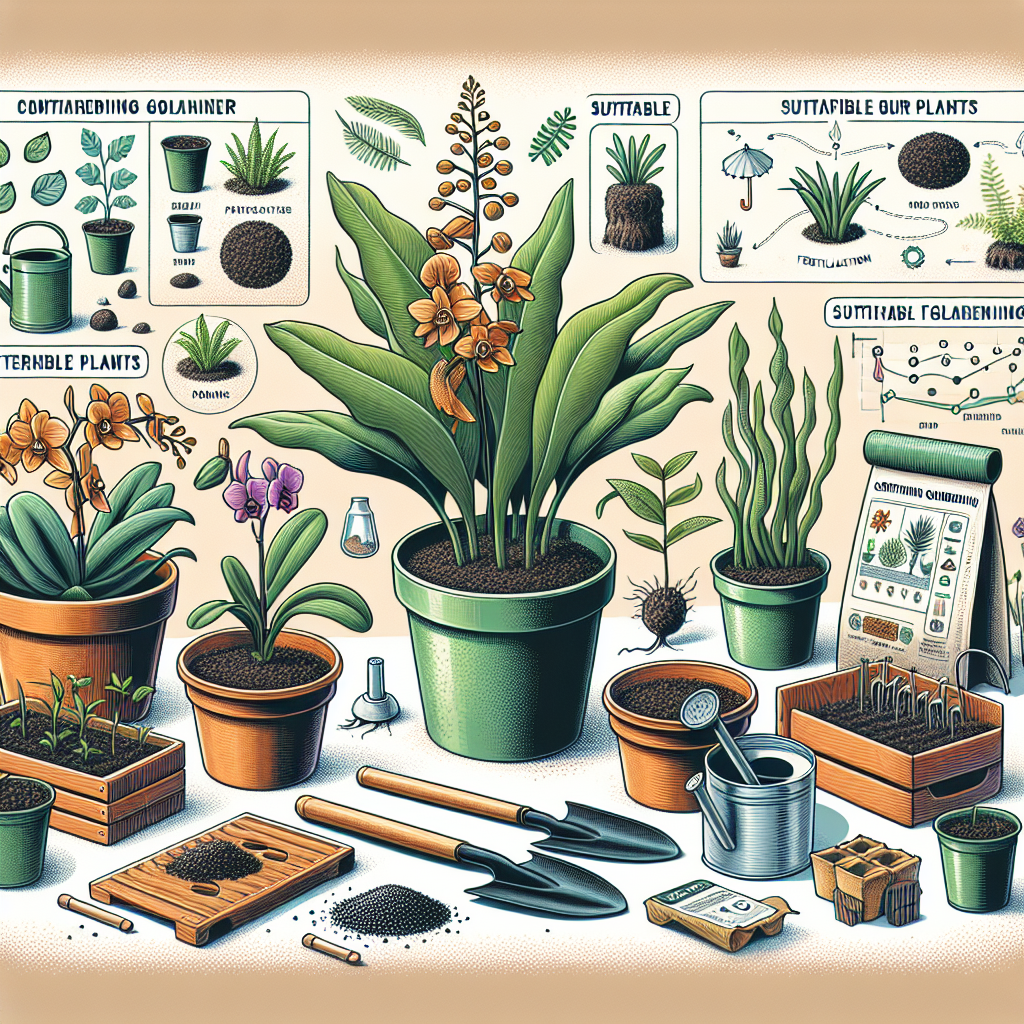
If you’ve ever dreamed of having a garden but thought you don’t have enough space, time, or resources, then container gardening could be the perfect solution for you. This beginner’s guide to container gardening in the Philippines will show you that gardening is possible no matter how limited your space might be. Whether you live in a small apartment or a bustling city, you can create a beautiful and thriving garden right on your balcony or rooftop. With the right tools and a little bit of knowledge, you’ll be able to grow your own vegetables, herbs, and flowers in containers, bringing nature right to your doorstep. Say goodbye to the limitations of traditional gardening and hello to the limitless possibilities of container gardening in the Philippines.

Choosing the Right Containers
Consider the space available
When it comes to container gardening in the Philippines, the first step is to consider the space you have available. Whether you have a small balcony, a rooftop, or a spacious backyard, it’s important to choose containers that fit well in the given space. Take measurements and consider the layout of your garden to determine the number and size of containers you can accommodate.
Select the appropriate size
The size of your containers is also an important factor to consider. For smaller plants, such as herbs or small flowering plants, smaller containers will suffice. However, if you plan on growing larger plants or vegetables, you will need larger containers to provide enough space for their roots to grow. Keep in mind that larger containers also require more soil and water to keep the plants healthy.
Evaluate the material
Containers can be made from a variety of materials, including plastic, clay, ceramic, and wood. Each material has its own advantages and disadvantages. Plastic containers are lightweight and easy to move around, but they may not be as aesthetically pleasing as ceramic or clay pots. Clay pots provide good airflow to the roots but may be more prone to cracking. Consider the climate and your personal preferences when choosing the material for your containers.
Ensure proper drainage
Proper drainage is crucial for container gardening success. Without adequate drainage, excess water can lead to root rot and other plant diseases. Make sure your containers have drainage holes at the bottom to allow excess water to escape. You can also place a layer of gravel or broken pottery at the bottom of the containers to improve drainage.
Selecting the Ideal Plants for Container Gardening
Determine the sunlight requirements
Before choosing plants for your container garden, it’s important to consider the sunlight requirements of the plants. Some plants thrive in full sun, while others prefer partial shade. Take note of the amount of sunlight your garden receives throughout the day and choose plants that will thrive in that specific lighting condition.
Opt for native or adapted plants
In the Philippines, it is recommended to opt for native or adapted plants for your container garden. These plants are well-suited to the local climate and are more likely to thrive in the conditions you provide. Native plants also provide valuable resources for local wildlife and contribute to the overall biodiversity of your garden.
Consider the size and growth habit
When selecting plants for your container garden, consider the size and growth habit of the plants. Some plants, like certain varieties of tomatoes or peppers, can become quite tall and may require staking or trellising to support their growth. Other plants, such as trailing vines or ornamental grasses, can add a cascading or vertical element to your container garden.
Choose plants that complement each other
To create an aesthetically pleasing container garden, choose plants that complement each other in terms of color, texture, and growth habit. Pairing plants with contrasting colors can create a visually interesting display, while mixing plants with varying foliage textures can add depth and dimension to your containers. Consider the overall look and feel you want to achieve and select plants accordingly.

Preparing the Containers
Clean the containers
Before planting, it’s important to clean the containers to ensure the health of your plants. Remove any debris or old soil from the containers, and wash them with a mild soap and water solution. This will help remove any potential pests, diseases, or residue that could harm your plants.
Add a layer of drainage material
To improve drainage in your containers, add a layer of drainage material at the bottom. This can be gravel, crushed stones, or even broken pottery. This layer will prevent the drainage holes from getting clogged and allow excess water to flow freely, preventing waterlogging and root rot.
Choose the right potting mix
Selecting the right potting mix is crucial for the success of your container garden. Avoid using garden soil as it tends to be heavy and may not provide adequate drainage. Instead, choose a high-quality potting mix that is lightweight, well-draining, and rich in organic matter. Look for potting mixes specifically formulated for container gardening.
Consider using organic fertilizers
When preparing your containers, consider using organic fertilizers to provide essential nutrients to your plants. Organic fertilizers release nutrients slowly, providing a steady supply over time. This can help prevent over-fertilization and reduce the risk of damaging your plants. Look for fertilizers made from natural sources, such as compost or well-rotted manure.
Planting Techniques for Container Gardening
Planting from seeds
One popular planting technique for container gardening is planting from seeds. This allows you to have control over the entire growth process, from seed to harvest. Follow the instructions on the seed packet regarding planting depth and spacing, and make sure to provide adequate moisture and sunlight for germination.
Transplanting seedlings
If you prefer to start with more established plants, you can also transplant seedlings into your containers. This can be especially useful if you have limited time or want to ensure a higher success rate. When transplanting, make sure to gently loosen the plant’s roots and provide ample space in the container for the roots to grow.
Using cuttings or divisions
Another planting technique is using cuttings or divisions. This involves taking a cutting or division from an existing plant and rooting it in a container. This method is particularly useful for plants that readily produce new growth or have a spreading habit. Before planting, make sure to dip the cuttings or divisions in rooting hormone and provide them with the appropriate growing conditions.
Consider companion planting
Companion planting is the practice of planting different species of plants together in the same container for mutual benefit. Some plants have natural pest-repellent properties or can improve the growth and flavor of neighboring plants. Research companion planting combinations that work well together and experiment with different combinations in your container garden.

Caring for Your Container Garden
Watering
One of the most important aspects of caring for your container garden is proper watering. Containers can dry out more quickly than traditional garden beds, so it’s important to monitor the moisture levels regularly. Water your plants thoroughly, making sure that the water reaches the roots. Avoid overwatering, as this can lead to root rot, and water in the early morning or late evening to prevent evaporation.
Feeding and fertilizing
Container plants rely on you to provide them with the necessary nutrients. Regularly fertilize your plants to ensure they receive the nutrients they need for healthy growth. Follow the instructions on the fertilizer packaging for application rates and frequencies. Additionally, consider periodically adding organic matter, such as compost or worm castings, to enrich the soil and boost plant health.
Pruning and trimming
To keep your container garden looking its best, regular pruning and trimming are necessary. Remove any dead or damaged foliage, as well as any overcrowded branches or stems. This will improve air circulation and prevent the spread of diseases. Additionally, trimming back certain plants can promote bushier growth and encourage the development of more flowers or fruits.
Controlling pests and diseases
Pests and diseases can pose a threat to your container garden, so it’s important to be proactive in their control. Regularly inspect your plants for signs of pests or diseases, such as chewed leaves, unusual spots, or wilting. If you notice any issues, promptly take action to mitigate the problem. This can include introducing beneficial insects, using organic pest control methods, or removing affected plants.
Design and Placement of Container Gardens
Create a focal point
When designing your container garden, consider creating a focal point that draws the eye. This can be accomplished by placing a larger, eye-catching plant or decorative element in the center of your display. Surrounding this focal point with smaller plants can further enhance its visual impact and create a sense of balance and harmony.
Consider the color scheme
Another important aspect of container garden design is considering the color scheme. Choose plants with complementary or contrasting colors to create visually appealing compositions. For example, pairing plants with orange and blue flowers can create a striking color combination. Consider the overall mood or theme you want to convey and select plants accordingly.
Ensure proper spacing
When placing your containers, ensure proper spacing between them to allow for adequate air circulation and growth. This is especially important for larger plants that require more room to spread out. Overcrowding containers can lead to increased competition for resources and can make it more difficult to care for individual plants.
Adjustable containers for changing seasons
In the Philippines, where weather conditions can vary throughout the year, consider using adjustable containers that can accommodate changing seasons. Some containers feature removable sides or panels that allow you to expand or contract the size of the container. This flexibility can be particularly useful when transitioning plants from indoors to outdoors or when accommodating the growth of certain plants.

Managing Microclimates in Containers
Consider the location
Container gardens offer the advantage of being mobile, allowing you to place them in the optimal location for your plants’ needs. Consider the microclimate of your garden, including factors such as sunlight exposure, wind patterns, and nearby structures or walls. Place your containers in locations that provide the ideal conditions for your plants to thrive.
Provide shade if necessary
In the hot and sunny climate of the Philippines, it may be necessary to provide shade for certain plants to prevent sunburn or heat stress. This can be achieved by placing your containers in areas with filtered sunlight or providing shade cloth or umbrellas to shield plants from direct sunlight during the hottest parts of the day.
Protection from strong winds
Strong winds can be damaging to container plants, causing them to dry out more quickly and potentially tipping over or breaking. If your garden is exposed to strong winds, consider placing containers in protected areas or using windbreaks, such as trellises, fences, or strategically placed structures, to shield your plants.
Manage temperature variations
Temperature variations, especially during colder months or in urban areas with heat island effects, can impact the health of your container plants. Consider using insulating materials, such as bubble wrap or horticultural fleece, to protect your plants from extreme temperatures. Additionally, be vigilant in monitoring temperature fluctuations and adjust your care routine accordingly.
Seasonal Considerations for Container Gardening
Choosing plants for each season
Container gardens offer the flexibility to change and adapt throughout the seasons. Take advantage of this by choosing plants that thrive in each specific season. For example, during the cooler months, you can grow leafy greens, cool-season flowers, and herbs. In the hotter months, opt for heat-tolerant plants, such as succulents or tropical flowers.
Adjusting watering and feeding
As the seasons change, the watering and feeding needs of your plants will also change. During the cooler months or rainy season, reduce the frequency of watering to prevent waterlogged soil. Conversely, during the hotter months, you may need to increase watering to account for increased evaporation. Adjust your feeding schedule accordingly to provide the appropriate nutrients for your plants’ specific seasonal requirements.
Protecting plants from extreme weather
Extreme weather events, such as typhoons or heavy rains, can pose a risk to your container garden. Monitor weather forecasts and take necessary precautions to protect your plants. This can include moving containers to sheltered areas, securing them with stakes or ties, or covering them with protective materials.

Troubleshooting Common Container Gardening Issues
Yellowing or wilting leaves
If you notice yellowing or wilting leaves on your container plants, it may be a sign of watering issues or nutrient deficiencies. Check the moisture level of the soil and adjust your watering routine accordingly. Additionally, consider fertilizing your plants with a balanced organic fertilizer to provide the necessary nutrients for healthy growth.
Root-bound plants
Root-bound plants occur when the roots outgrow their container and become tightly packed. This can limit the plant’s ability to absorb nutrients and water, leading to stunted growth or other issues. To remedy this, gently loosen the plant’s roots and consider repotting it into a larger container with fresh potting mix.
Overwatering or underwatering
Overwatering or underwatering are common mistakes in container gardening. Overwatering can lead to root rot, while underwatering can cause dehydration and plant stress. Monitor the moisture level of the soil regularly and adjust your watering schedule accordingly. Stick your finger about an inch into the soil – if it feels dry, it’s time to water, but if it feels moist, hold off for another day or two.
Pests and diseases
Pests and diseases can be a challenge in container gardening. Common pests include aphids, mealybugs, and spider mites, while diseases like powdery mildew or fungal infections can also occur. Regularly inspect your plants for signs of pests or diseases and take appropriate action. This can include using organic pest control methods, introducing beneficial insects, or removing affected plants to prevent the spread of disease.
Conclusion
Container gardening in the Philippines offers a wonderful opportunity to grow a variety of plants in limited spaces. By considering factors such as container selection, plant choice, proper preparation, planting techniques, care, design, and seasonal considerations, you can create a thriving container garden that adds beauty and greenery to your surroundings. With a little effort and attention, you can enjoy the rewards of container gardening all year round. So go ahead and start your own container garden adventure – your plants will thank you!





